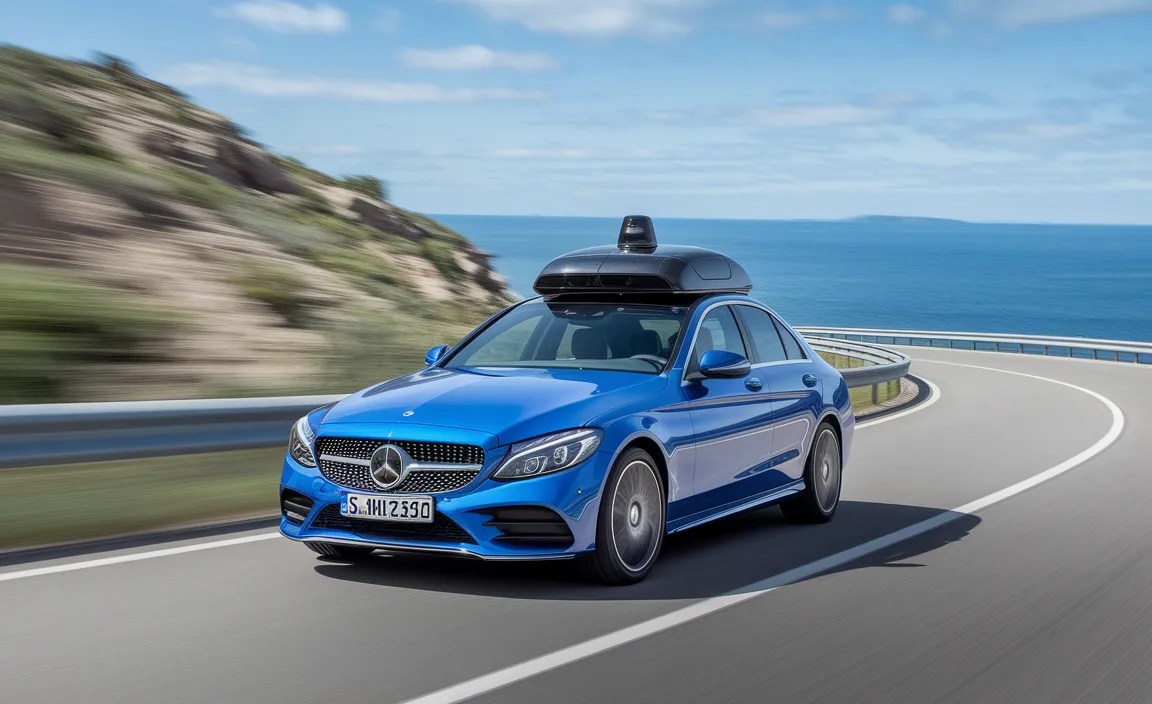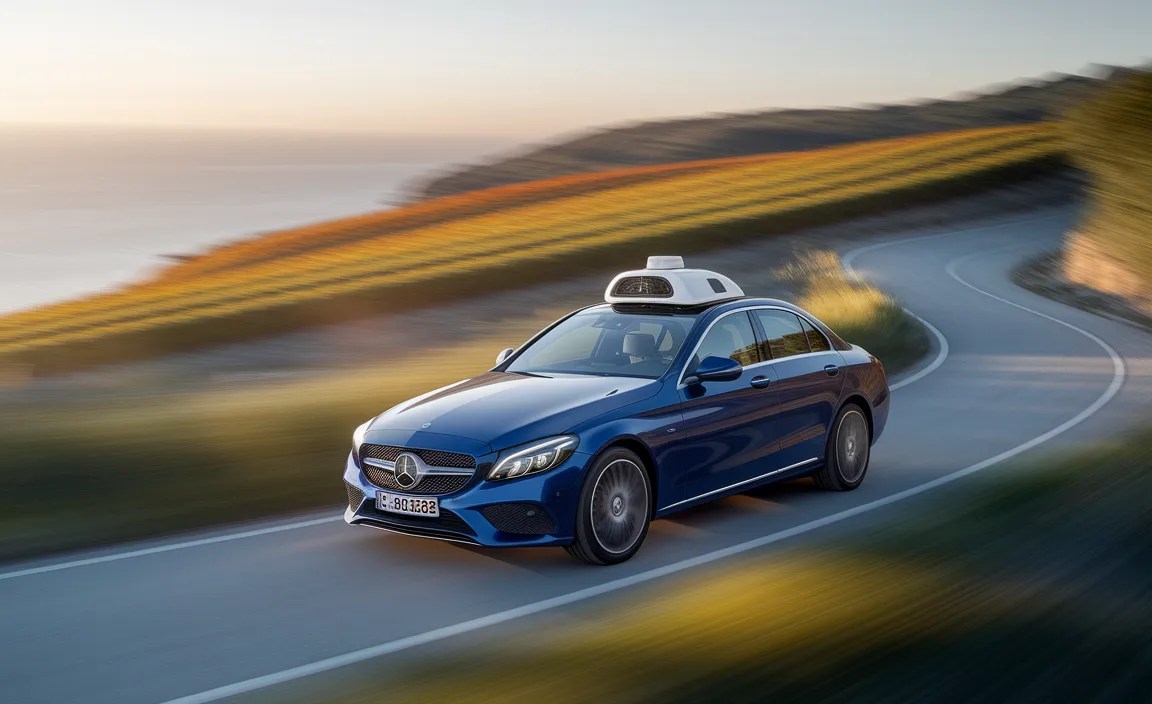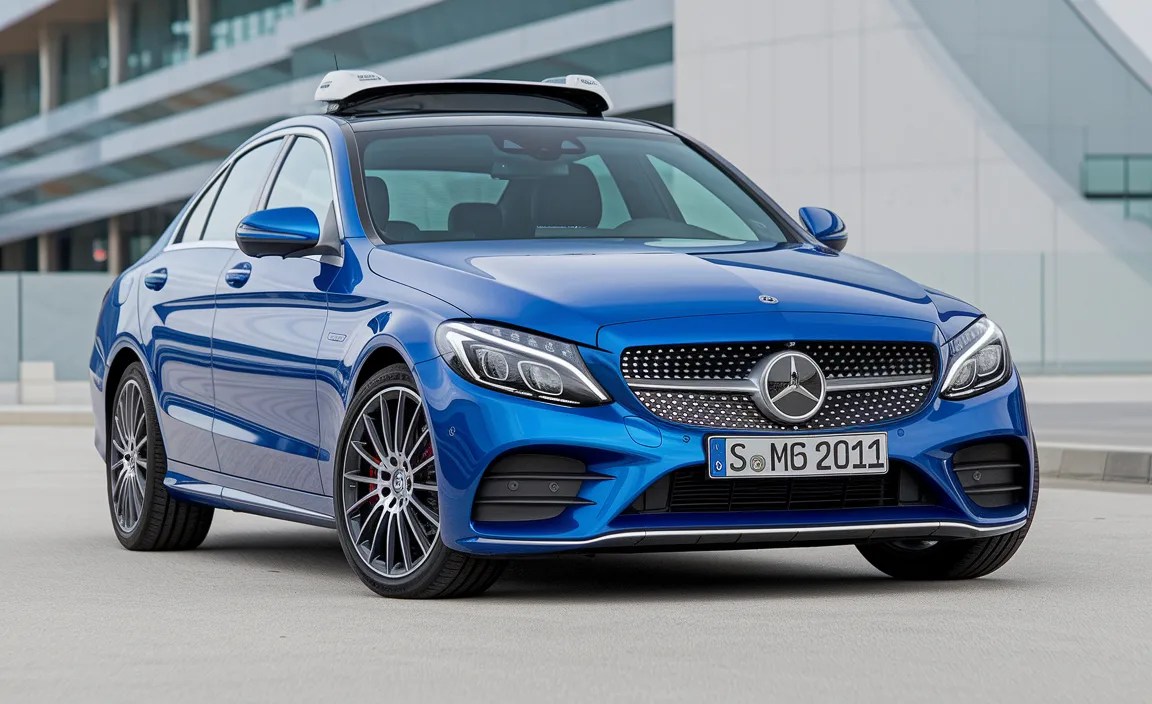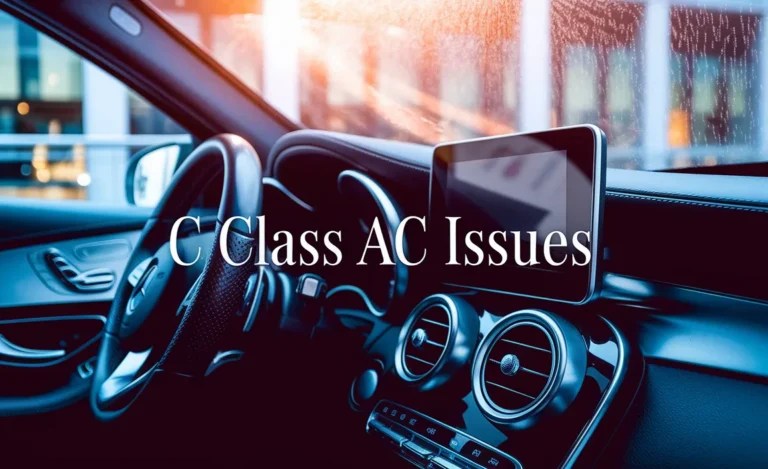Mercedes-Benz C-Class Autonomous Features: Ultimate Driving
The Mercedes-Benz C-Class offers advanced autonomous driving features that enhance safety and convenience. These systems, like Active Distance Assist DISTRONIC and Active Steering Assist, work together to help manage speed, steering, and braking, making your journeys more relaxed and secure. Understanding and using them correctly unlocks a superior driving experience.
Welcome to the world of the Mercedes-Benz C-Class, where luxury meets cutting-edge technology. For many drivers, the idea of “autonomous features” might sound complex, perhaps even a little intimidating. But what if I told you these intelligent systems are designed to make your driving experience not only safer but also more comfortable and effortless?
Think of them as a highly skilled co-pilot, always ready to assist. We’ll demystify these sophisticated technologies, breaking down exactly what they are, how they work, and how you can best use them to elevate your time behind the wheel of your C-Class.

Understanding C-Class Autonomous Features: Your Digital Co-Pilot
Mercedes-Benz has long been a pioneer in automotive innovation, and the C-Class is a prime example of this commitment. The “autonomous features” you’ll find in a C-Class are not about taking the driving away from you entirely, but rather about augmenting your capabilities as a driver. These advanced driver-assistance systems (ADAS) use a network of sensors, cameras, and radar to perceive the world around your car.
They can then react to traffic situations, help you maintain your lane, and even adjust your speed automatically. Essentially, they are designed to reduce driver fatigue, improve safety, and make navigating traffic less stressful, especially on long journeys or in busy urban environments.

The goal of these C-Class autonomous features is to provide a more relaxed and secure driving experience. They work collaboratively, forming a sophisticated network of support that understands your surroundings and anticipates potential hazards. This means you can arrive at your destination feeling more refreshed and confident, knowing that your vehicle is actively assisting you.
The Core Technologies Powering Autonomous Driving in the C-Class
At the heart of the C-Class’s autonomous capabilities are several key technologies:
- Radar Sensors: These emit radio waves that bounce off objects around the car, detecting their distance and speed.
- Cameras: Mounted on the windshield or mirrors, cameras recognize lane markings, traffic signs, other vehicles, pedestrians, and cyclists.
- Ultrasonic Sensors: Commonly used for parking, these emit sound waves to detect very close objects.
- Lidar (Light Detection and Ranging): Some advanced systems may incorporate Lidar for highly detailed 3D mapping of the environment.
- Sophisticated Software Algorithms: This is the “brain” that processes data from all sensors, making decisions and controlling vehicle functions.
These components work in harmony, creating a comprehensive understanding of the vehicle’s surroundings. This allows the C-Class to offer features that go far beyond simple cruise control or parking assistance.
Key C-Class Autonomous Features Explained
Let’s dive into the specific autonomous features you’re likely to find in a modern Mercedes-Benz C-Class. While exact availability can depend on the model year and optional packages, these are the most prominent:
Active Distance Assist DISTRONIC
This is Mercedes-Benz’s advanced adaptive cruise control system. DISTRONIC doesn’t just maintain a set speed; it can automatically adjust your speed to keep a safe distance from the vehicle in front. If the car ahead slows down, your C-Class will too, and if it speeds up or changes lanes, DISTRONIC will resume your set speed.
- How it works: Uses radar sensors to monitor the distance and speed of the vehicle ahead.
- Benefits: Significantly reduces the burden of stop-and-go traffic and highway cruising. Helps prevent tailgating and provides a smoother driving experience.
- Activation: Typically activated via buttons on the steering wheel. You set your desired speed and a following distance (usually indicated by bars or time intervals).
Imagine driving on the highway, and the car in front of you suddenly brakes. DISTRONIC reacts faster than you might, smoothly applying the brakes to maintain a safe gap. When traffic clears, it accelerates you back to your set speed, all without you needing to touch the pedals.
Active Steering Assist
When combined with DISTRONIC, Active Steering Assist takes another significant step towards autonomous driving. It uses cameras to detect lane markings and can actively help you keep the vehicle centered within its lane. On highways, it can even subtly steer the car around curves.
- How it works: Cameras identify lane markings, road edges, and even softer boundaries like grass verges.
- Benefits: Reduces the constant micro-adjustments needed to stay in lane, especially on long, monotonous drives. Eases the steering effort required.
- Limitations: It requires clear lane markings to function reliably. Driver attention is still paramount; it’s an assistance system, not self-driving.
This feature is particularly helpful on long road trips. It takes some of the constant, subtle steering corrections out of your hands, allowing you to focus more on the overall driving situation rather than just keeping the car perfectly centered.
Active Brake Assist
This is a critical safety feature designed to help prevent or mitigate front-end collisions. Active Brake Assist uses radar and camera systems to monitor traffic ahead. If it detects a potential collision with a vehicle, pedestrian, or cyclist, it will first issue a visual and audible warning. If you don’t react, it can then apply partial or full braking autonomously.
- How it works: Radar and camera systems constantly scan the path ahead for potential obstacles.
- Benefits: Acts as an essential safeguard, potentially avoiding accidents or reducing their severity.
- Intervention: Provides driver warnings before intervening with autonomous braking.
This system is a testament to Mercedes-Benz’s dedication to safety, acting as a vigilant guardian against common accident scenarios.
Traffic Sign Assist
This feature reads and displays detected speed limits and other traffic signs (like “Do Not Enter”) on your instrument cluster or the head-up display. It can sometimes also warn you if you exceed the detected speed limit.
- How it works: A camera specifically scans for traffic signs.
- Benefits: Helps you stay aware of speed limits, especially in unfamiliar areas or when signs are obscured.
- Integration: Can often be linked with DISTRONIC to automatically adjust your set speed to the detected limit.
Navigating through different speed zones can become second nature with this intelligent assistant, ensuring compliance and safety.
Active Lane Change Assist
Available on models equipped with the Driving Assistance Package Plus, this feature can semi-autonomously change lanes on the highway when conditions are safe. If you activate the turn signal, and the system detects that the adjacent lane is clear and the speed differential is appropriate, it will guide the car into that lane.
- How it works: Uses radar sensors and cameras to monitor surrounding traffic and lane markings.
- Activation: Initiated by activating the turn signal.
- Driver Input: Requires clear driver intent and confirmation by holding the turn signal stalk longer.
This can be a convenient feature for overtaking slower vehicles on multi-lane roads, easing the process with a gentle, controlled maneuver.
Lane Keeping Assist & Active Lane Keeping Assist
Standard Lane Keeping Assist can often detect when the car is drifting out of its lane unintentionally (e.g., due to driver inattention) and can subtly steer the car back into the lane. Active Lane Keeping Assist, part of more advanced packages, offers more sophisticated intervention, including potentially braking the wheels on one side to steer the vehicle back.
- How it works: Cameras monitor lane markings.
- Intervention: Provides steering input to correct unintended lane departures.
- Driver Awareness: Designed to alert and correct, not to provide continuous steering control.
These systems are crucial for preventing accidents caused by drivers unintentionally drifting out of their lane.
Blind Spot Assist / Active Blind Spot Assist
This system uses radar sensors to monitor the blind spots on both sides of your vehicle. It warns you if it detects a vehicle in your blind spot. Active Blind Spot Assist can go a step further by applying braking to one side of the car to help prevent a collision during an attempted lane change if a vehicle is detected in the blind spot.
- How it works: Radar sensors scan the areas beside and slightly behind the vehicle.
- Warning: Typically indicated by a visual warning light in the side mirror.
- Active Intervention: Can automatically apply brakes to prevent a dangerous lane change.
This is an indispensable tool for improving safety, especially in multi-lane traffic.
How to Use C-Class Autonomous Features Effectively
These incredible features empower you by reducing driving stress, but they demand your understanding and engagement. Here’s how to use them wisely:

1. Know Your Package
Not all C-Classes come with every advanced feature. Consult your owner’s manual or your vehicle’s specifications to understand which Driving Assistance Packages were installed. This will tell you precisely which features are available.
2. Understand System Limitations
These are assistance systems, not fully autonomous driving solutions. They rely on clear road markings, good weather conditions, and properly functioning sensors. Heavy rain, snow, fog, faded lane lines, or complex road construction can impair their performance. Always maintain situational awareness.
3. Activate and Set Clearly
Most systems are activated via steering wheel controls. Take a moment to familiarize yourself with these buttons. For DISTRONIC, set your desired speed and a comfortable following distance. For lane-keeping systems, ensure they are active when you intend them to be.
4. Monitor System Status
Your C-Class’s instrument cluster or central display will provide visual cues about the status of these features. Look for icons indicating when DISTRONIC is active, when lane keeping is engaged, or if a system is temporarily unavailable due to conditions.
5. Be Ready to Take Over
The most crucial aspect of using these features is being prepared to take full control at any moment. These systems are designed to assist, not replace, the driver. Hands should remain on the wheel, and your attention should always be on the road.
6. Practice in Safe Environments
Start by using these features in predictable conditions, like on a relatively empty highway. Gradually increase your comfort as you become more familiar with how the car reacts in different scenarios. Avoid trying to fully rely on them in complex city driving or adverse weather until you are very confident.
C-Class Autonomous Features vs. Traditional Cruise Control and Lane Departure Warning
It’s easy to confuse advanced autonomous features with simpler driver aids. Here’s a quick comparison:

| Feature | Functionality | C-Class Autonomous Equivalent |
|---|---|---|
| Traditional Cruise Control | Maintains a set speed regardless of traffic. | Active Distance Assist DISTRONIC: Maintains set speed AND adjusts to traffic ahead. |
| Lane Departure Warning (LDW) | Alerts the driver (audibly/visually) when the car drifts out of its lane. | Lane Keeping Assist / Active Lane Keeping Assist: Warns AND can actively intervene with steering/braking to keep the car in lane. |
| Parking Sensors | Detect obstacles during parking maneuvers. | Active Parking Assist: Can autonomously steer, brake, and accelerate for parking. (Often uses Parking Sensors as part of the system). |
The key difference lies in the proactive and integrated nature of the C-Class’s systems. They don’t just warn you; they actively assist in managing speed, steering, and braking, creating a more seamless and less demanding driving experience.
Benefits of Utilizing C-Class Autonomous Features
Embracing these intelligent systems offers a wealth of advantages:
- Enhanced Safety: Features like Active Brake Assist and Active Blind Spot Assist are designed to prevent accidents.
- Reduced Driver Fatigue: Systems like DISTRONIC and Active Steering Assist significantly alleviate the physical and mental strain of driving, especially on long journeys or in traffic.
- Improved Fuel Efficiency: Smooth acceleration and deceleration managed by DISTRONIC can optimize fuel consumption compared to erratic human inputs.
- Increased Convenience: Navigating traffic jams or highway cruising becomes far more comfortable when the car handles some of the repetitive tasks.
- Confidence Building: As you become more familiar with how these systems work and their benefits, they can foster a greater sense of control and confidence on the road.
When to Rely on and When to Be Wary of Autonomous Features
Understanding the optimal conditions for these features is key to maximizing their benefit and ensuring safety.

Ideal Conditions:
- Highway Driving: Well-marked highways are the perfect environment for ACC, Active Steering Assist, and Active Lane Change Assist.
- Moderate Traffic: DISTRONIC excels in managing speed and distance in highway traffic, reducing the stress of stop-and-go situations.
- Clear Weather: Sunny days with good visibility allow cameras and sensors to function at their best.
- Familiar Roads: When you know the road layout and potential hazards, you can better anticipate how the systems will behave.
Conditions Requiring Caution or Manual Override:
- Heavy Rain, Snow, or Fog: These conditions can obscure lane markings and compromise sensor effectiveness.
- Construction Zones: Lane changes, temporary markings, and unexpected obstacles can confuse autonomous systems.
- Sharp or Unmarked Curves: Lane keeping systems may struggle if markings are unclear or absent, or in very tight turns.
- Complex Urban Environments: Busy city streets with diverse road users (cyclists, pedestrians, unpredictable drivers) demand full driver attention and direct control.
- Poorly Maintained Roads: Potholes, uneven surfaces, or faded lane lines can interfere with system operation.
- Emergencies: Always be ready to override the system in unexpected or critical situations where immediate, decisive human judgment is needed.
The U.S. Department of Transportation’s National Highway Traffic Safety Administration (NHTSA) provides valuable insights into the capabilities and limitations of advanced driver-assistance systems, emphasizing that drivers must remain engaged. For more information on vehicle safety technologies, you can visit the NHTSA’s official page on automated driving features.
FAQ: Your C-Class Autonomous Feature Questions Answered
Here are some common questions our readers ask about the C-Class’s autonomous driving capabilities:
Q1: Are C-Class autonomous features truly “self-driving”?
A1: No. While sophisticated, they are advanced driver-assistance systems (ADAS). They enhance safety and comfort but require the driver to remain attentive and ready to intervene at all times. True self-driving vehicles are not yet available for consumer purchase.
Q2: How do I turn on Active Distance Assist DISTRONIC?
A2: DISTRONIC is typically activated using buttons on the left side of the steering wheel. You’ll usually press an “ON/OFF” button to enable the system, then set your desired speed with a “+” or “-” button, and adjust the following distance with another dedicated button.
Q3: What happens if the lane markings are unclear?
A3: Lane Keeping Assist and Active Steering Assist rely on clear lane markings. If the markings are faded, covered by snow, or absent, these systems may become unavailable or less effective. The vehicle’s display will usually indicate when these systems are not operational.
Q4: Can these features help me in heavy snow?
A4: While some systems offer limited functionality in adverse weather, heavy snow can significantly impair sensor and camera performance. It’s crucial to be extra cautious and primarily rely on manual driving in such conditions.
Q5: Do C-Class autonomous features use a lot of battery power?
A5: These systems are designed to be efficient and draw power from the vehicle’s main electrical system, which is replenished by the alternator when the engine is running. They do not significantly impact battery life in a way that would typically cause concern.
Q6: How can I disable a specific autonomous driving feature if I don’t want to use it?
A6: Most individual features can be turned on or off through the vehicle’s infotainment system settings or via buttons on the steering wheel. Consult your owner’s manual for the exact procedure for each feature.
Q7: Is it safe to take my hands off the steering wheel when Active Steering Assist is on?
A7: Absolutely not. While Active Steering Assist helps with steering, it is not designed for hands-off driving. Mercedes-Benz systems are designed to detect if your hands are off the wheel for too long and will prompt you to put






